Exercise 3.3 from CENGAGE PHYSICS (ENGLISH) Chapter 11:ELECTRIC POTENTIAL for Class 12
| Class 12 | PHYSICS |
| Chapter | ELECTRIC POTENTIAL |
| CENGAGE PHYSICS (ENGLISH) | Exercise 3.3 |
| Medium | English |
| Academic Year | 2023-2024 |
Question 9
a. A circle is drawn with center as a charge +q. What is the work done in moving a charge +q from B to C along the circumferebce of the circle ?
B In the above question, if the charge +q is first taken from B to A and then from A to C, on which path is the magnitude of work greater?
 View Solution
View SolutionQuestion 12
If you carry out the integral of the electric field ∫→E.→dl for a closed path like that as shown in (Fig. 3.40), the integral will always be equal tom zero, independent of the shape of the path and independent of where charges may be located relative to the path. Explain why.
 .View Solution
.View SolutionQuestion 15
When charge 10μC is shifted from inifinity to a point in an electric field, it is found that work done by eletrotatic forces is 10μJ. If the charge is doubled and taken again from inifinity to the same point without accelerating it, then find the amount of work done by electric field and against electric field.View SolutionQuestion 18
Four balls, each with mass m, are connected by four nonconducting strings to from a square with side with A, as shown in (Fig. 3.43.) The assembly is placed on a horizontal nonconducting frictionless surface. Balls 1 and 2 each have charge q, and balls 3 and 4 are uncharged. Find the maximum speed of balls 1 and 2 after the string connecting them is cut.
 .View Solution
.View SolutionQuestion 26
A simple pendulum of length l and bob mass m is hanging in front of a large nonconducting sheet having surface charge density σ. If suddenly a charge +q is given to the bob & it is released from the position shown in figure. Find the maximum angle through which the string is deflected from vertical .
 .View Solution
.View SolutionQuestion 27
An insulating rod having linear charge density λ=40.0μCm−1 and linear mass density μ=0.100kgm−1 is released from rest in a uniform electric field E=100Vm−1 directed perpendicular to the rod.
(a) Determine the speed of the rod after it has travelled 2.00 m
(b) How does your answer to part (a) change if the electric field is not perpendicular to the rod ?
 View Solution
View SolutionQuestion 28
Three concentric spherical conductors of radii a, 2a, and 3a have charges −Q,+2Q, and −4Q, respectively. If r is the distance of the point under consideration from the center of the spheres, then find the electric field and potential due to the given configuration, for the values
(i) r<a
(ii) a<r<2a
(iii) 2a<r<3a
r>3a.
 .View Solution
.View SolutionQuestion 30
As shown in (Fig. 3.90), two large parallel vertical conducting plates separated by distance D are charge so that their potential are +V0 and −V0. A small conducting ball of mass m and radius r (whereR<<d) is hung midway between the plates. The thread of length L supporting the ball is a conducting wire connected to ground, so the potential of the ball is fixed at V=0. The ball hangs straight down in stable equilibrium when V0 is sufficiently small. Show that the equilibrium of the ball is unstable if V0 exceeds the critical value [ked2mg/(4RL)]1/2.
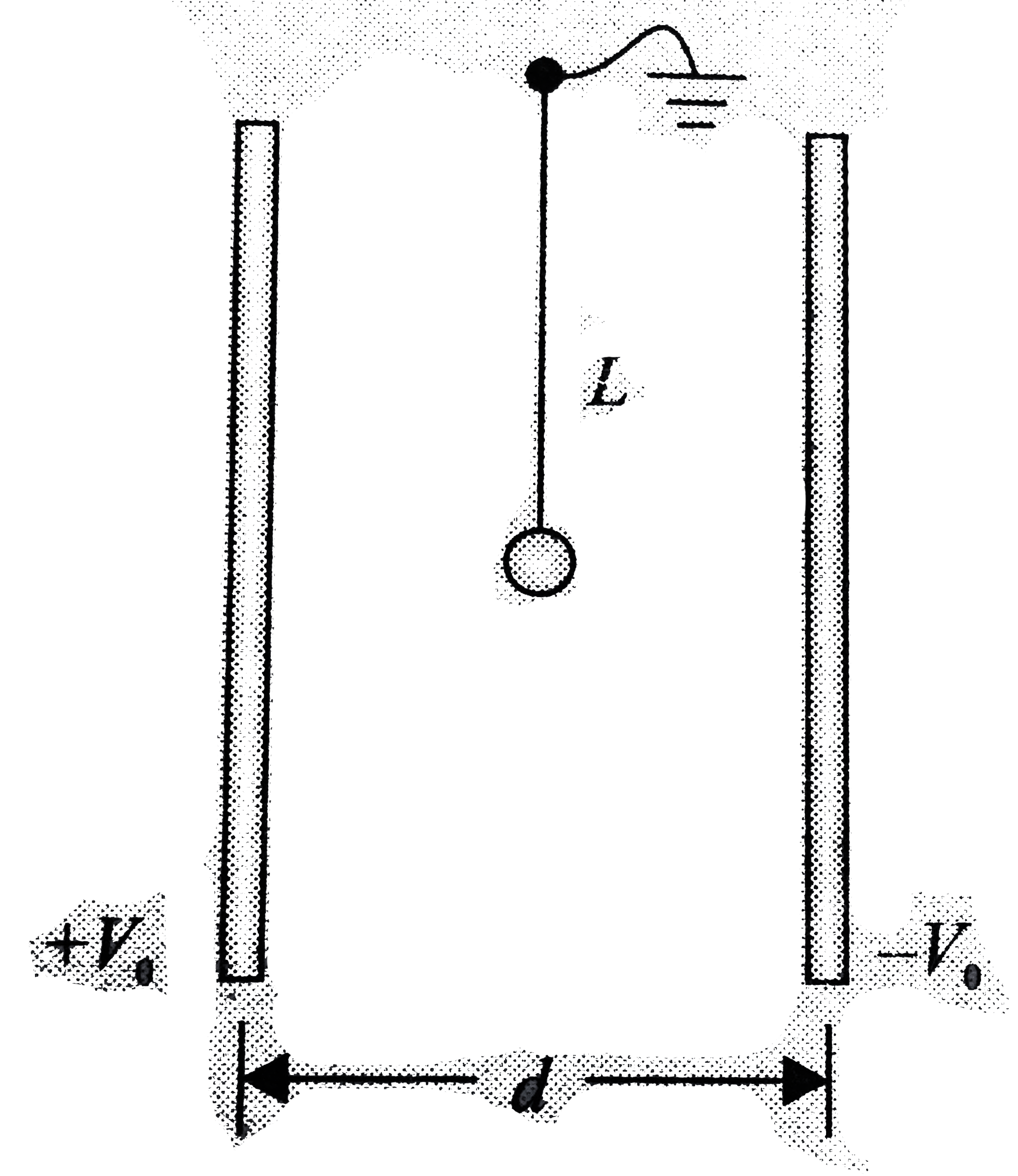 View Solution
View SolutionQuestion 31
Electrically charged drops of mercury fall from an altitude h into a spherical metal vessel of radius R. There is a small opening in the upper part of the vessel. The mass of each drop is m, and the charge on the drop is Q. What will be the number n of the last drop that can still enter the sphere?View SolutionQuestion 32
A small sphere of mass m=0.5kg carrying a positive charge q=110μC is connected with a light, flexible, and inextensible string of length of length r=60cm and whirled in a vertical circle. If a vertically upward electric field of strength E=105NC−1 exists in the space, calculate the minimum velocity of the sphere required at the highest point so that it may just complete the circle (g=10ms−2).View SolutionQuestion 34
An electric dipole consists of two opposite charges each of magnitude 1 mC separated by 2 cm. The dipole is placed in an external uniform field of 105NC−1 intensity. Find the
a. maximum torque exterted by the field on the dipole, and
b. work done in roating the dipole through 180∘ starting from the position θ=0∘.View SolutionQuestion 36
A In question 3, If the dipole rotates from orientation 1 to orientation 2, is the work done on the dipole by field positive, negative, or zero ?
B If, instead, the dipole rotates from the orientation 1 to orientation 4, is the work done by the field more than, less than, the same as in (a) ?View SolutionQuestion 37
The potential energies associated with four orientations of an electric dipole in an electric field are (1)−5U0,(2)−7U0,(3)3U0,and(4)5U0, where U0 is positive. Rank the orientation according to the angle between the electric dipole moment →P and the electric field →E, and B magnitude of the torque on the electric dipole, greatest first.View SolutionQuestion 38
A neutral water molecule (H2O) in its vapour state has an electric dipole moment of magnitude 6.2×10−30cm.
a. How far apart are the molecules' centers of positive and negative charge ?
b. If a molecule is placed in an electric field of 1.5×104NC−1, what maximum torque can the field exert on it ? (Such a field can easily be set up in the laboratory).
c. How much work must an external agent do to turn this molecule end for end in this field, starting from its fully aligned position, for which θ=0 ?View SolutionQuestion 46
Water from a tap, maintained at a costant potential V, is allolwed to fall by drops of radius r through a small hole into a hollow conducting sphere of radius R standing on an insulating stand until it fills the entire sphere. Find the potential of the hollow conductor after it is completely filled with water.View SolutionQuestion 48
Figure shows a large conducting ceiling having uniform charge particle of charge density σ below which a charge particle of charge q0 and mass m is hung from point O, through a small string of length l. Calculate the minimum horizontal velocity v required for the string to become horizontal.
 .View Solution
.View SolutionQuestion 49
A nonconducting sphere of radius R=5cm has its center at the origin O of the coordinate system as shown in (Fig. 3.112). It has two spherical cavities of radius r=1cm, whose centers are at 0,3cm and 0,−3cm, respectively, and solid material of the sphere has uniform positive charge density ρ=1/πμCm−3. Calculate the electric potential at point P(4cm,0).
 .View Solution
.View SolutionQuestion 51
Three conducting spherical shells have radii (a, b, and c) such that a<b<c (Fig. 3.113). Initially, the inner shell is uncharged, the middle shell has a positive charge Q, and the outer shell has a negative charge −Q.
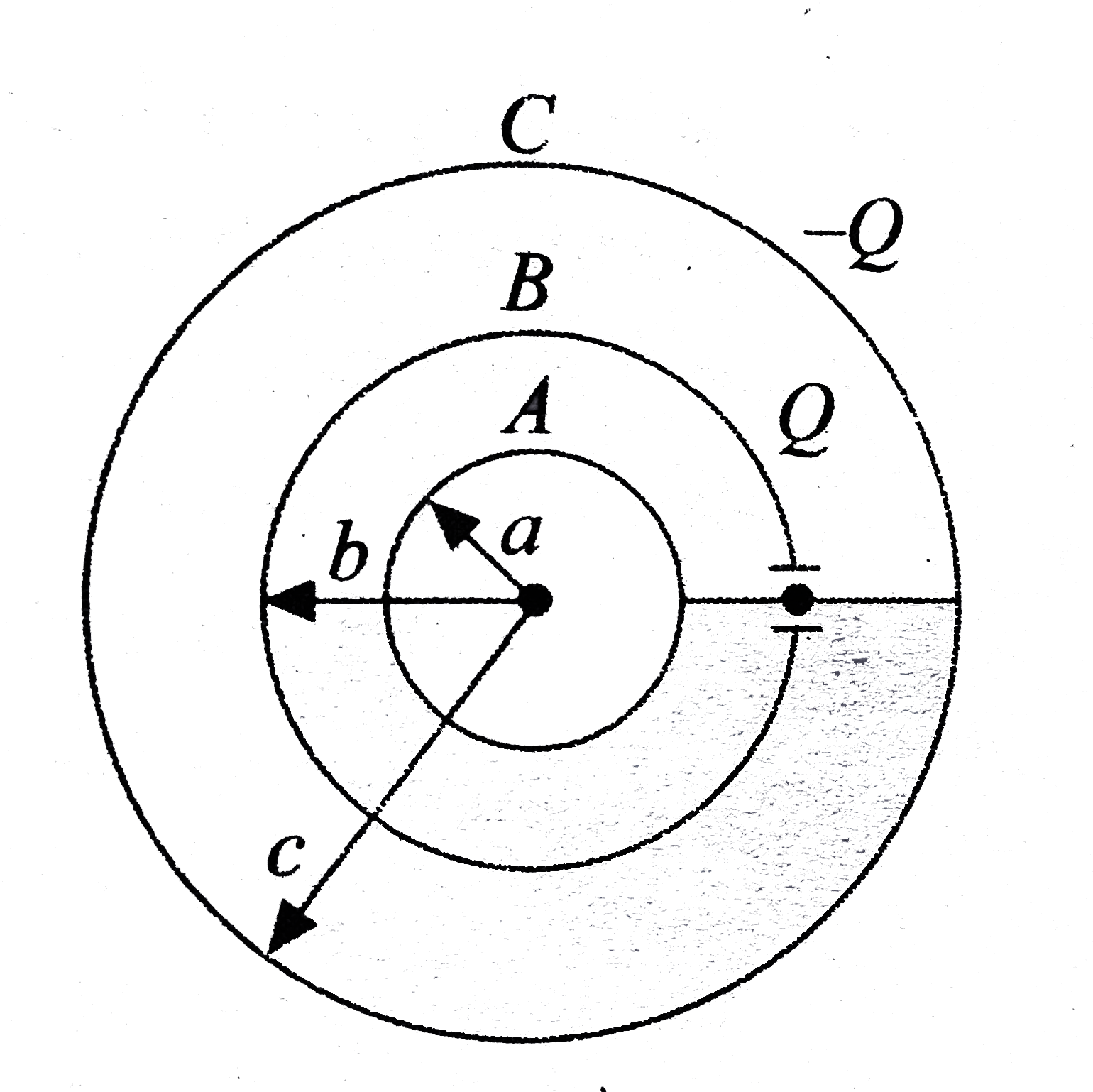 .
.
a. Find the electric potential of the three shells.
b. If the inner and outer shells are now connected by a wire that is insulated as it passes through the middle shell, what is the electric potential of each of the three shells ? Also, what is the final charge on each shell ?View SolutionQuestion 53
Two concentric shells of radii R and 2R are shown in (Fig. 3.115). Initially, a charge q is imparted to the inner shells. Now, key K1 is closed and opened and then key K2 is closed and opened. After the keys K1andK2 are alterbately closed n times each, find the potential difference between the shells. Note that finally key K2 remains closed.
 .View Solution
.View SolutionQuestion 54
Three charges each of value q are placed at the corners of an equilateral triangle. A fourth charge Q is placed at the center of the triangle.
a. Find the net force on charge q.
b. If Q=−q, will the charges at the corners move toward the center or fly away from it ?
c. For what value of Q at O will the charges remain stationary ?
d. In situation (c), how much work is done in removing the charges to infinity?View SolutionQuestion 55
A small ball of mass 2×10−3kg, having a charge 1μC, is suspended by a string of length 0.8m. Another identical ball having the same charge is kept at the point of suspension. Determine the minimum horizontal velocity that should be imparted to the lower ball so that it can make a complete revolution.View SolutionQuestion 57
A point charge q is located at the centre O of a spherical uncharged coducting layer provided with small orifice. The inside and outside radii of the layer are equal to a and b respectively. The amount of work that has to be performed to slowly transfer the charge q from teh point O through the orifice and into infinity is
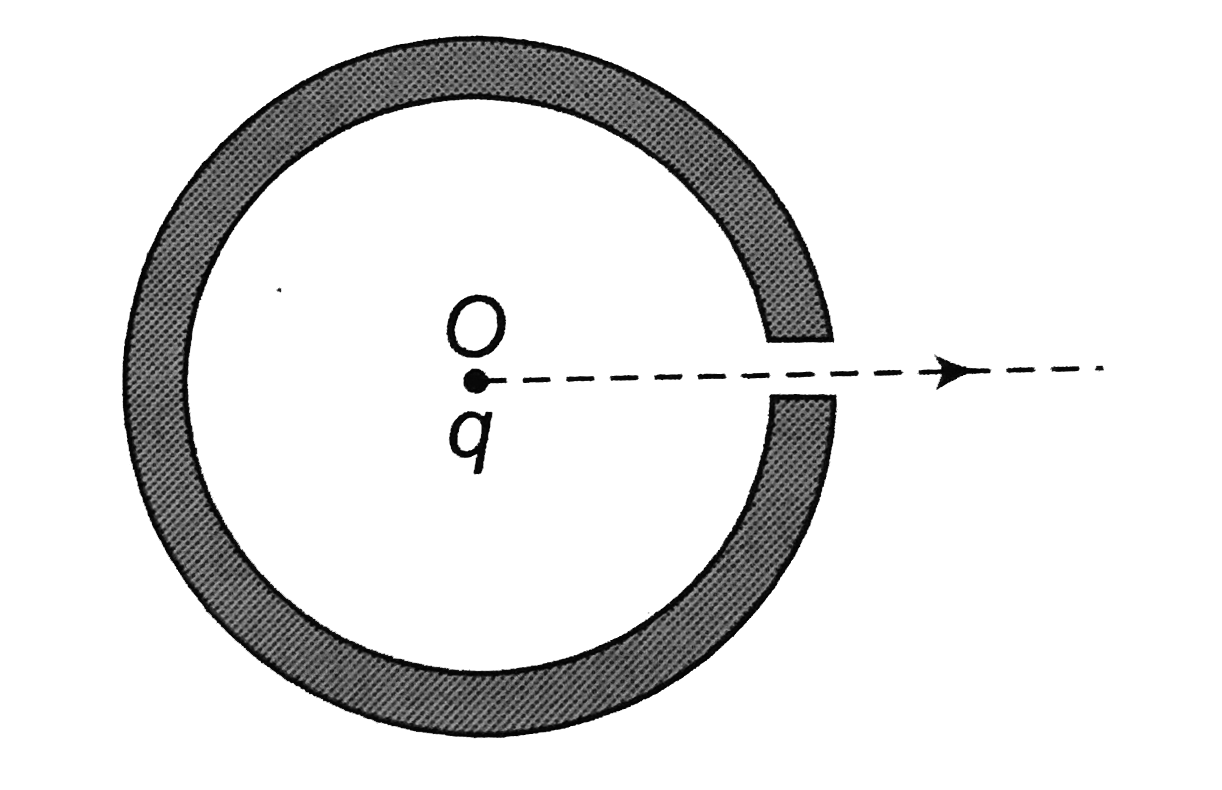 View Solution
View SolutionQuestion 58
Four point charges +8μC−1μC,−1μCand+8μC are fixed at the points −√27/2m,−√3/2m+√3/2mand+√27/2m respectively on the Y-axis. A particle of mass 6×10−4 kg and charge +0.1μC moves along the -X direction. It speed at x=+∞ is v0. Find the least value of v0 for which the paticle will cross the origin. Find also the kinetic energy of the particle at the origin. Assume that space is gravity free.View SolutionQuestion 60
Two uniformly charged large plane sheets S1 and S2 having charge densities σ1 and σ2 (σ1>σ2) are placed at a distance d parallel to each other. A charge q0 is moved along a line of length a(altd) at an angle 45∘ with the normal to S1. Calculate the work done by the electric fieldView SolutionQuestion 63
A short dipole is placed along the x - axis at x=x (Fig. 3.120).
 .
.
a. Find the force acting on the dipole due to a point charge q placed at the origin.
b. Find the force on the dipole if the dipole is rotated by 180∘ about the z- axis.
c. Find the force on dipole if the dipole is rotated by 90∘ anticlockwise about z - axis, i.e., it becomes parallel to the y - axis.View SolutionQuestion 65
Four charge particles each having charge Q=1 C are fixed at the corners of the base(A,B,C, and D) of a square pyramid with slant length a(AP=BP=PC=a=√2m), a charge -Q is fixed at point P. A dipole with dipole moment p=1 C-m is placed at the center of the bases and perpendicular to its plane as shown in fig. Force on the dipole due to the charge particles is □4πε0N.
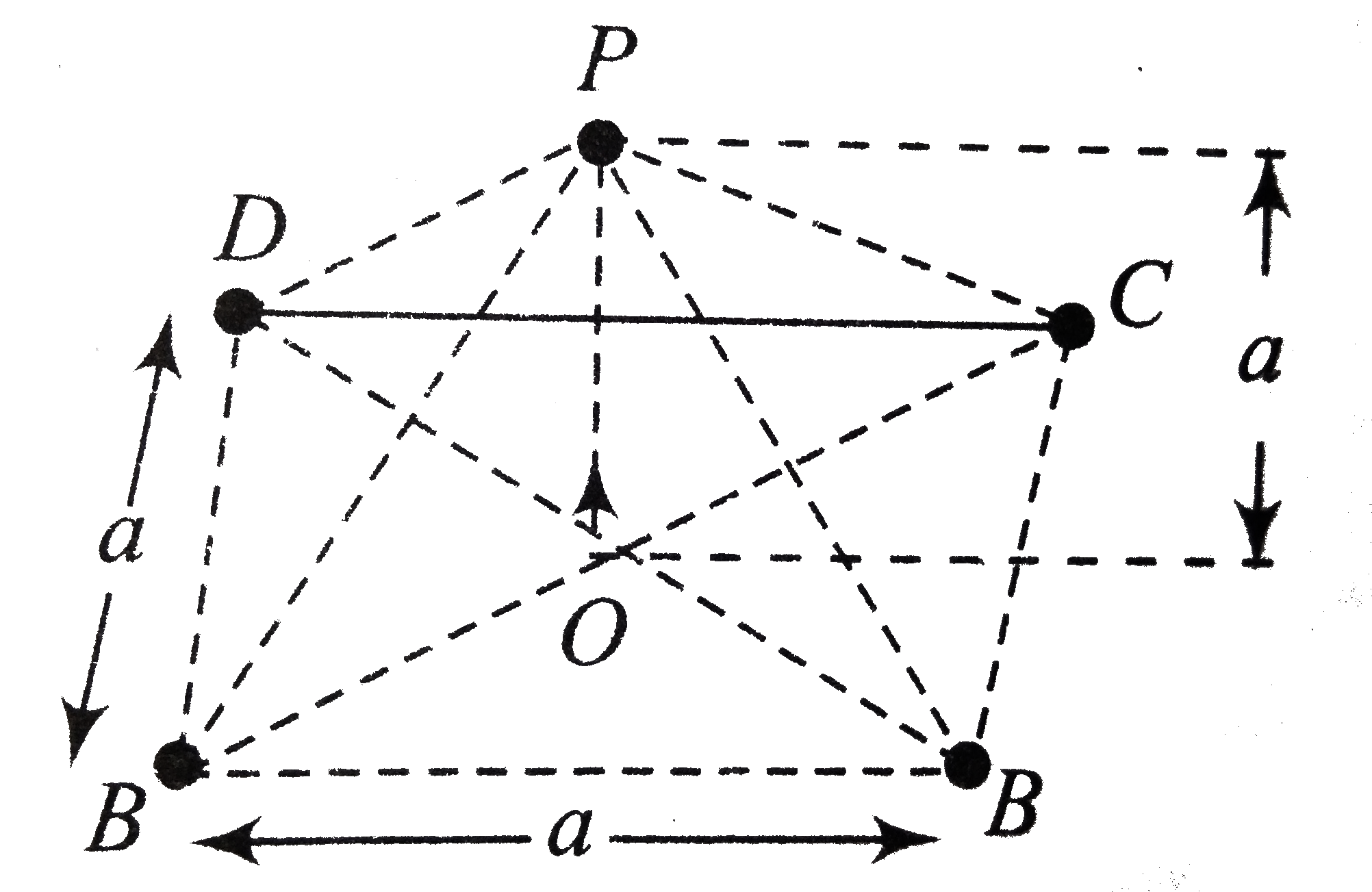 View Solution
View SolutionQuestion 67
A radioactive source, in the form of a metallic sphere of radius 10−2m emits β−particles at the rate of 5×1010 particles per second. The source is electrically insulated. How long will it take for its potential to be raised by 2V, assuming that 40% of the emitted β−particles escape the source.View SolutionQuestion 69
When a small uncharged conducting ball of radius a=1cm and mass m=50g is dropped from a height h above the center of another large conducting sphere of radius b(=1m) having charge Q(=(100μC). It rises to a height h1(=2m) after the collision. Find the value of h. Assume that during the impact there is no dissipation of energy.
 .View Solution
.View SolutionQuestion 75
The electric field at the origin is along the positive x-axis. A small circle is drawn with the centre at the origin cutting the axes at points A, B, C and D having coordinates (a,0), (0,a), (-a,0),(0,-a) respectively. Out of the points on the periphery of the circle, the potential is minimum at View SolutionQuestion 81
Two spherical conductors of radii R1andR2 are separated by a distance much larger than the radius of eighter sphere. The spheres are connected by a conducting wire as shown in (Fig. 3.128). If the charges on the spheres in equilibrium are q1andq2, respectively, what is the ratio of the field strength at the surfaces of the spheres ?
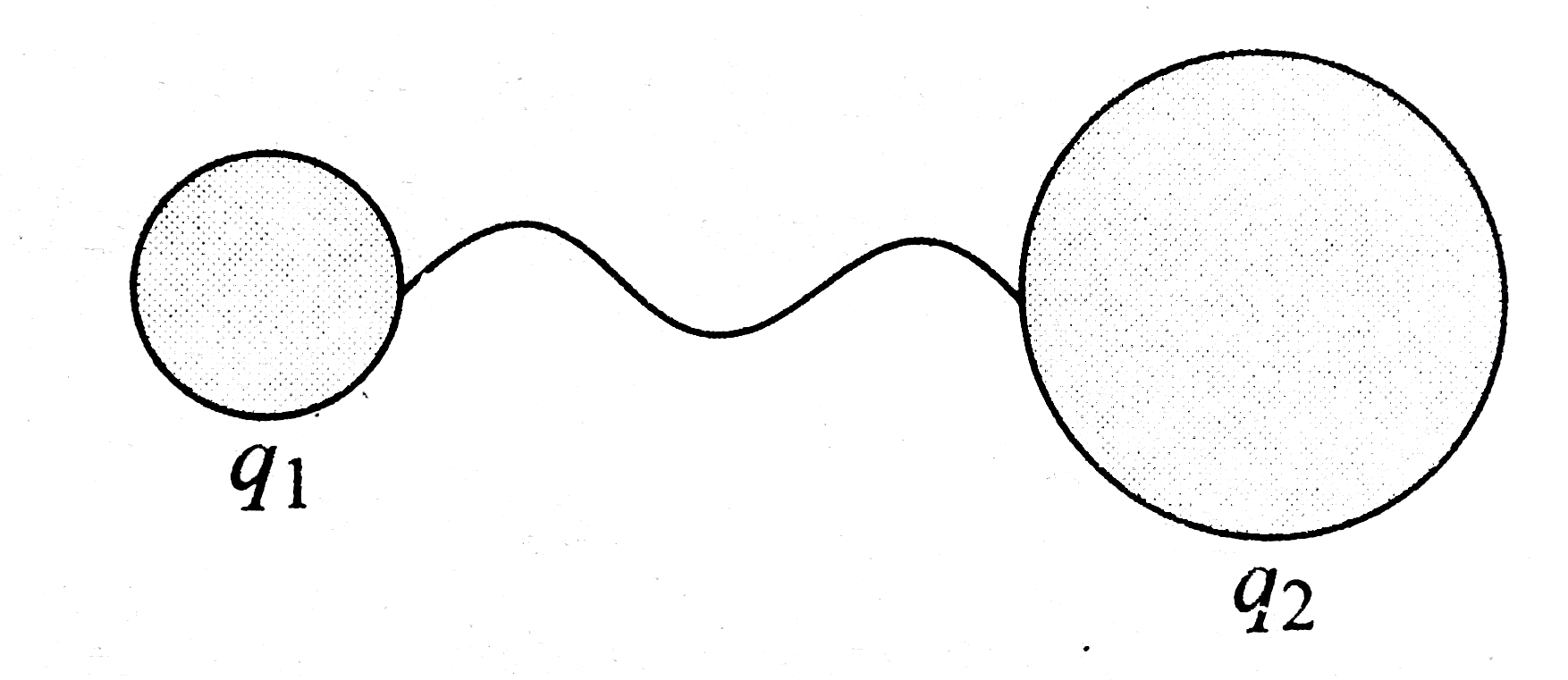 .View Solution
.View SolutionQuestion 95
An electron is fired directly towards the center of a large metal plate that has excess negative charge with surface charge density =2.0×10−6C/m2. If the initial kinetic energy of electron is 100 eV and if it is to stop due to repulsion just as it reaches the plate, how far from the plate must it be fired ?View SolutionQuestion 102
A small sphere with mass 1.2g hangs by a thread between two parallel vertical plates 5.00cm apart. The plates are insulating and have uniform surface charge densities +σand−σ. The charge on the sphere is q=9×10−6C. What potential difference between the plates will cause the thread to assume an angle of 37∘ with the vertical as shown in (Fig. 3.134) ?
 .View Solution
.View SolutionQuestion 103
A particle of mass m carrying charge q is projected with velocity v from point P toward aninfinite line of charge from a distance a . Its speed reduces to zero momentarily at point Q, which is at a distance a/2 from the line of charge. If another particle with mass m and charge −q is projected with the same velosity v from P toward the line of charge, what will be its speed at Q ?View SolutionQuestion 108
A conducting sphere A of radius a, with charge Q, is placed concentrically inside a conducting shell B of radius b. B is earthed. C is the common center of AandB. Study the following statements.
(i) The potential at a distance r from C, where
a≤r≤b,is14πε0(qr)
(ii) The potential difference between AandB is
14πε0Q(1r−1B)
(iii) The potential at a distance romC, where
a≤r≤b,is14πε0Q(1r−1B)
Which of the following statements are correct ?
 .View Solution
.View SolutionQuestion 111
Three identical metallic uncheged spheres A,B,andC, each of radius a, are kept at the corners of an equilateral triangle of side d(d>>a) as shown in (Fig. 3.137). The fourth sphere (of radius a), which has a charge q, touches A and is then removed a position far away. B is earthed and then the earth connection is removed. C is then earthed. The charge on C is
 .View Solution
.View SolutionQuestion 114
We have three identical metallic spheres A,B,andC. A is given a charge Q,andBandC are uncharged. The following processes of touching of two spheres are carried out in succession. Each process is carried out with sufficient time. ltbgt i. A and B
ii. B and C
iii. C and A
iv. A and B
v. B and C
The final charges on the spheres are.View SolutionQuestion 124
A unit positive point charge of mass m is projected with a velocity V inside the tunnel as shown. The tunnel has been made inside a uniformly charged nonconducting sphere. The minimum velocity with which the point charge should be projected such that it can reach the opposite end of the tunnel is equal to
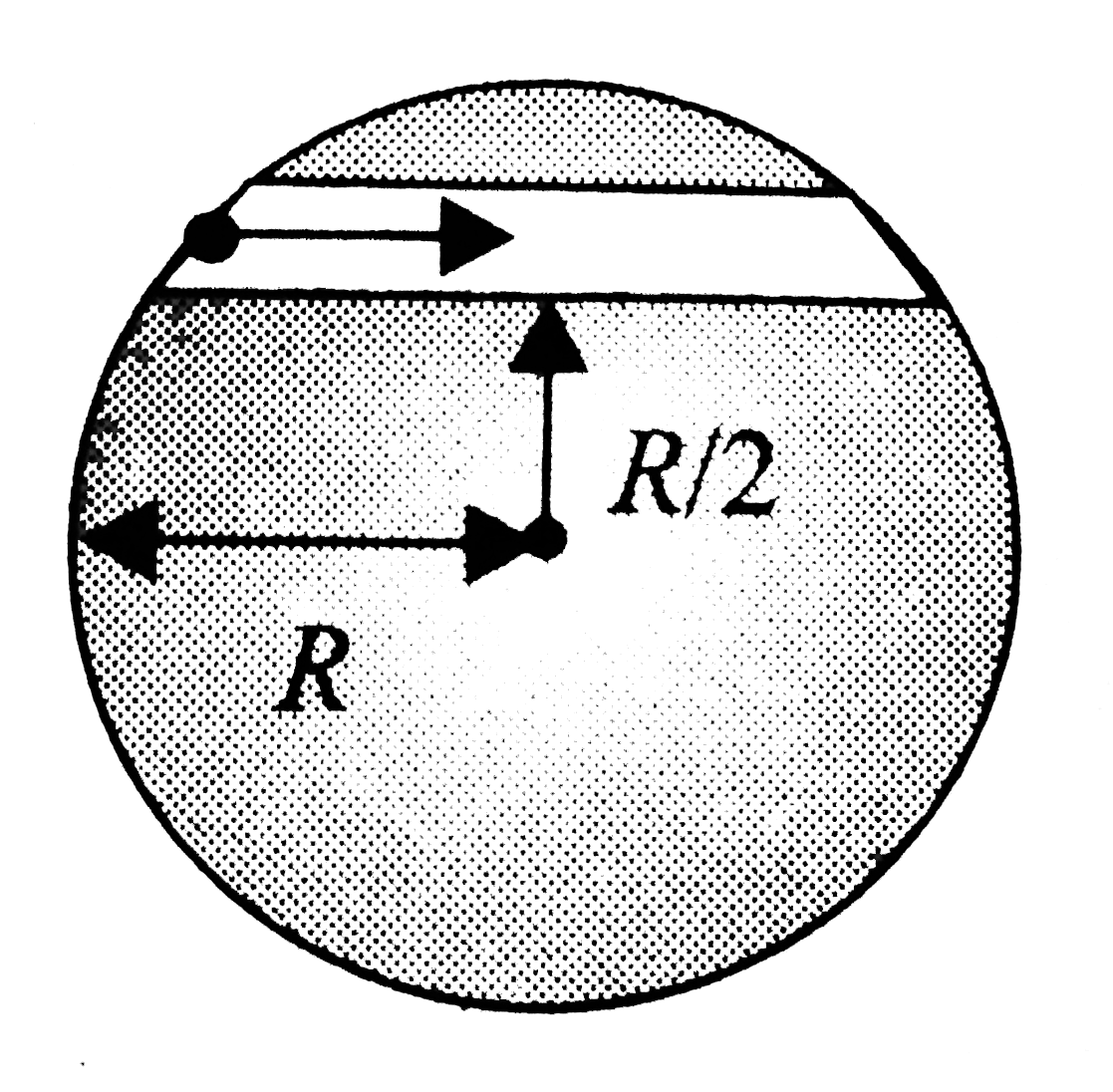 View Solution
View SolutionQuestion 125
Electric field given by the vector →E=xˆi+yˆj is present in the x y plane. A small ring carrying +Q, which can freely slide on a smooth nonconducting rod, is projected along the rod from the point (0,L) such that it can reach the other end of the rod. What minimum velocity should be given to the ring ? (Assume zero gravity).
 .View Solution
.View SolutionQuestion 126
A wire having a uniform linear charge density λ is bent in the form of a ring of radius R. Point A as shown in (Fig. 3.145) is in the plane of the ring but not at the center. Two elements of the ring of lengths a1 and a2 subtend very small same angle at point A. they are at distances r1 and r2 from point A, respectively (r2>r1).
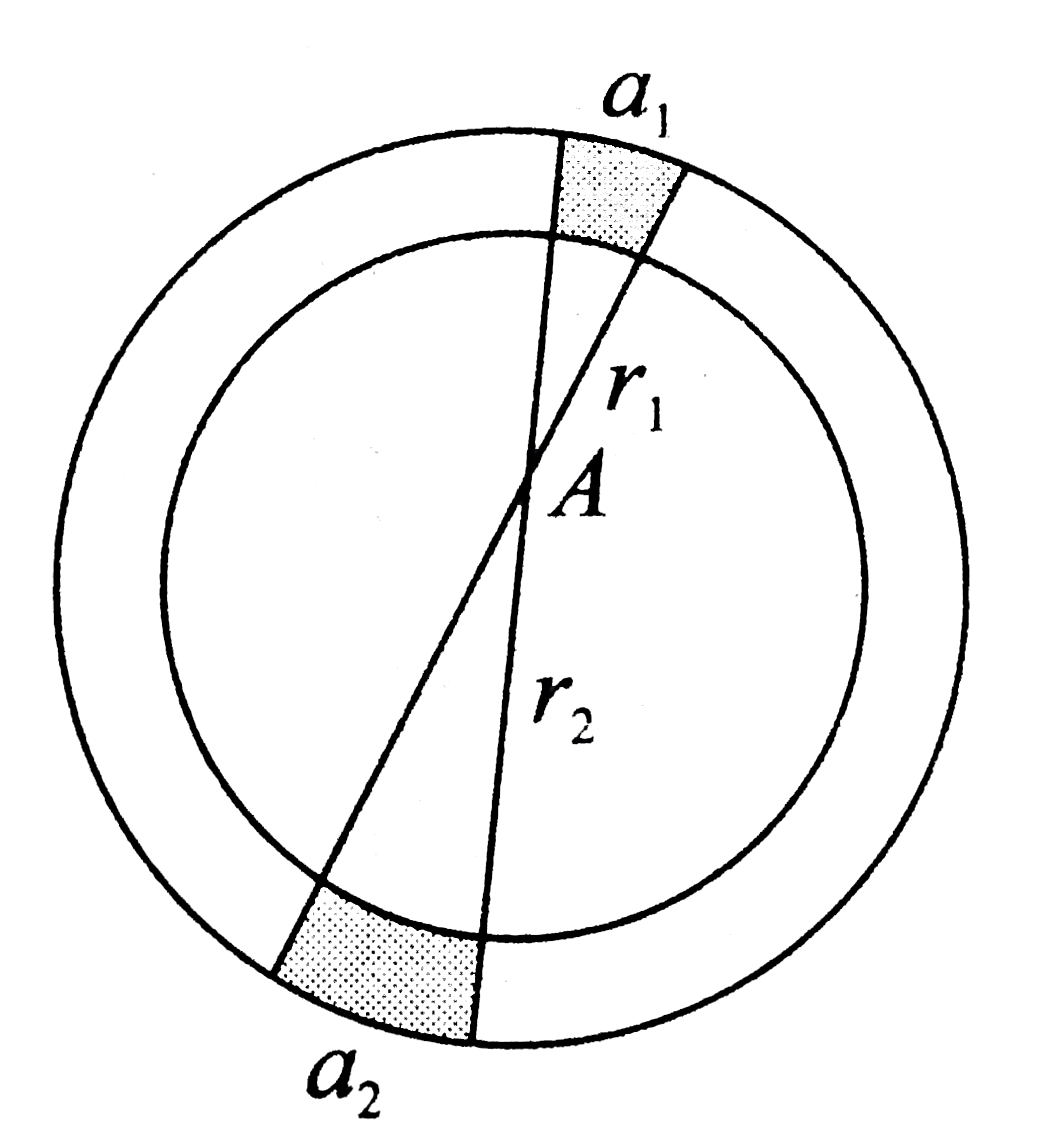 .View Solution
.View SolutionQuestion 138
A small metal sphere, carrying a net charge q1=−2μC, is held in a stationary position by insulating supports. A second small metal sphere, with a net charge of q2=−8μC and mass 1.50g, is projected toward q1. When the two spheres are 0.800m apart, q2 is moving toward q1 with speed 20ms−1 as shown in (Fig. 3.151). Assume that the two spheres can be treated as point charges. You can ignore the force of gravity.
 .
.
The speed of q2 when the spheres are 0.400m apart is.View SolutionQuestion 139
A small metal sphere, carrying a net charge q1=−2μC, is held in a stationary position by insulating supports. A second small metal sphere, with a net charge of q2=−8μC and mass 1.50g, is projected toward q1. When the two spheres are 0.800m apart, q2 is moving toward q1 with speed 20ms−1 as shown in (Fig. 3.151). Assume that the two spheres can be treated as point charges. You can ignore the force of gravity.
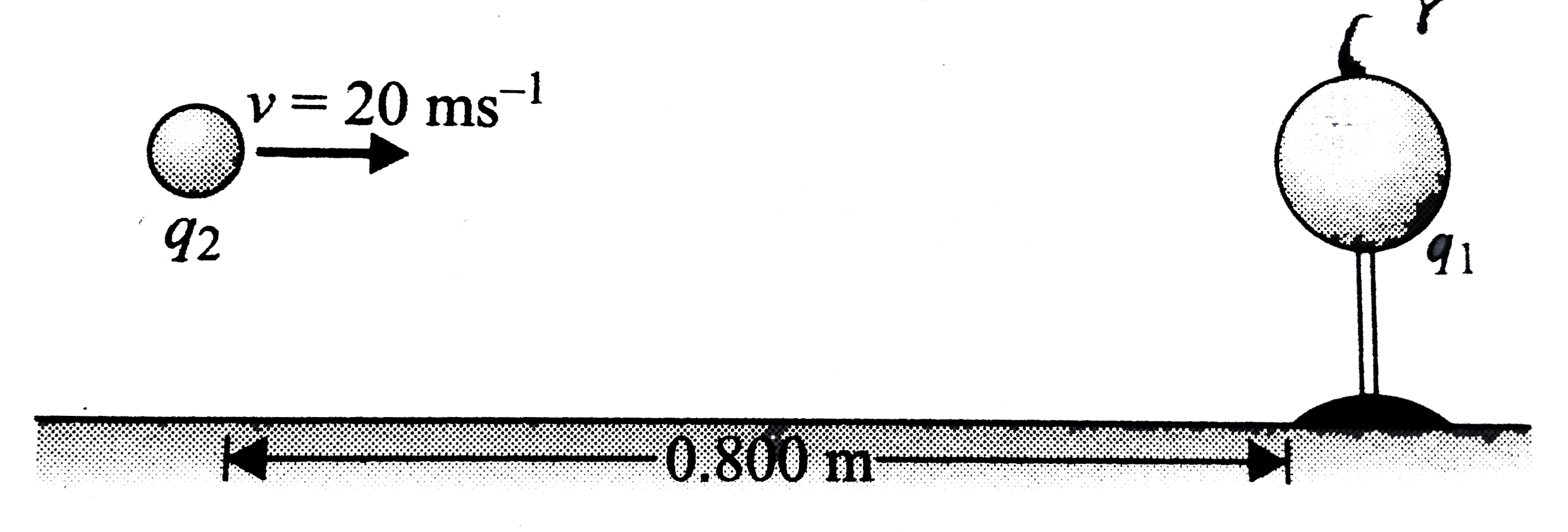 .
.
How close does q2 get to q1 ?View SolutionQuestion 151
The electric potential varies in space according to the relation V=3x+4y. A particle of mass 10 kg starts from rest from point (2,3.2) m under the influence of this field. Find the velocityr,f the particle when it crosses the x-axis. The charge on the particle is +1μC. Assume V (x, y)are in SI units. View SolutionQuestion 152
The electric potential varies in space according to the relation V=3x+4y. A particle of mass 10 kg starts from rest from point (2,3.2) m under the influence of this field. Find the velocityr,f the particle when it crosses the x-axis. The charge on the particle is +1μC. Assume V (x, y)are in SI units. View SolutionQuestion 153
The electric potential varies in space according to the relation V=3x+4y. A particle of mass 10 kg starts from rest from point (2,3.2) m under the influence of this field. Find the velocityr,f the particle when it crosses the x-axis. The charge on the particle is +1μC. Assume V (x, y)are in SI units. View SolutionQuestion 154
The electric potential varies in space according to the relation V=3x+4y. A particle of mass 10 kg starts from rest from point (2,3.2) m under the influence of this field. Find the velocityr,f the particle when it crosses the x-axis. The charge on the particle is +1μC. Assume V (x, y)are in SI units. View SolutionQuestion 155
Three concentric spherical metallic shells A,B,andC of radii a,b,andc(a<b<c) have surface charge densities σ,−σ and σ, respectively.
If VA,VB and VC are potential of shells A, B and C, respectively, match the columns
Column AColumn Ba.VAi.σε0[a2−b2+c2c]b.VBii.σ2ε0[a2b−b+c]c.VCiii.σε0[a−b+c]View SolutionQuestion 156
Three concentric spherical metallic shells A, B and C of radii a, b and c (a < b < c) have surface charge densities σ, −σ and σ respectively.
(i) Find the potential of the three shells A, B and C.
(ii) If the shells A and C are at the same potential, obtain the relation between the radii a, b and c.View SolutionQuestion 157
We have an isolated conducting spherical shell of radius 10cm. Some positive charge is given to it so that the resulting electric field has a maximum intensity of 1.8×106NC−1. The same amount of negative charge is given to another isolated conducting spherical shell of radius 20cm. Now, the first shell is placed inside the second so that both are concentric as shown in (Fig. 3.154).
 .
.
The electric potential at any point inside the first shell is.View SolutionQuestion 158
We have an isolated conducting spherical shell of radius 10cm. Some positive charge is given to it so that the resulting electric field has a maximum intensity of 1.8×106NC−1. The same amount of negative charge is given to another isolated conducting spherical shell of radius 20cm. Now, the first shell is placed inside the second so that both are concentric as shown in (Fig. 3.154).
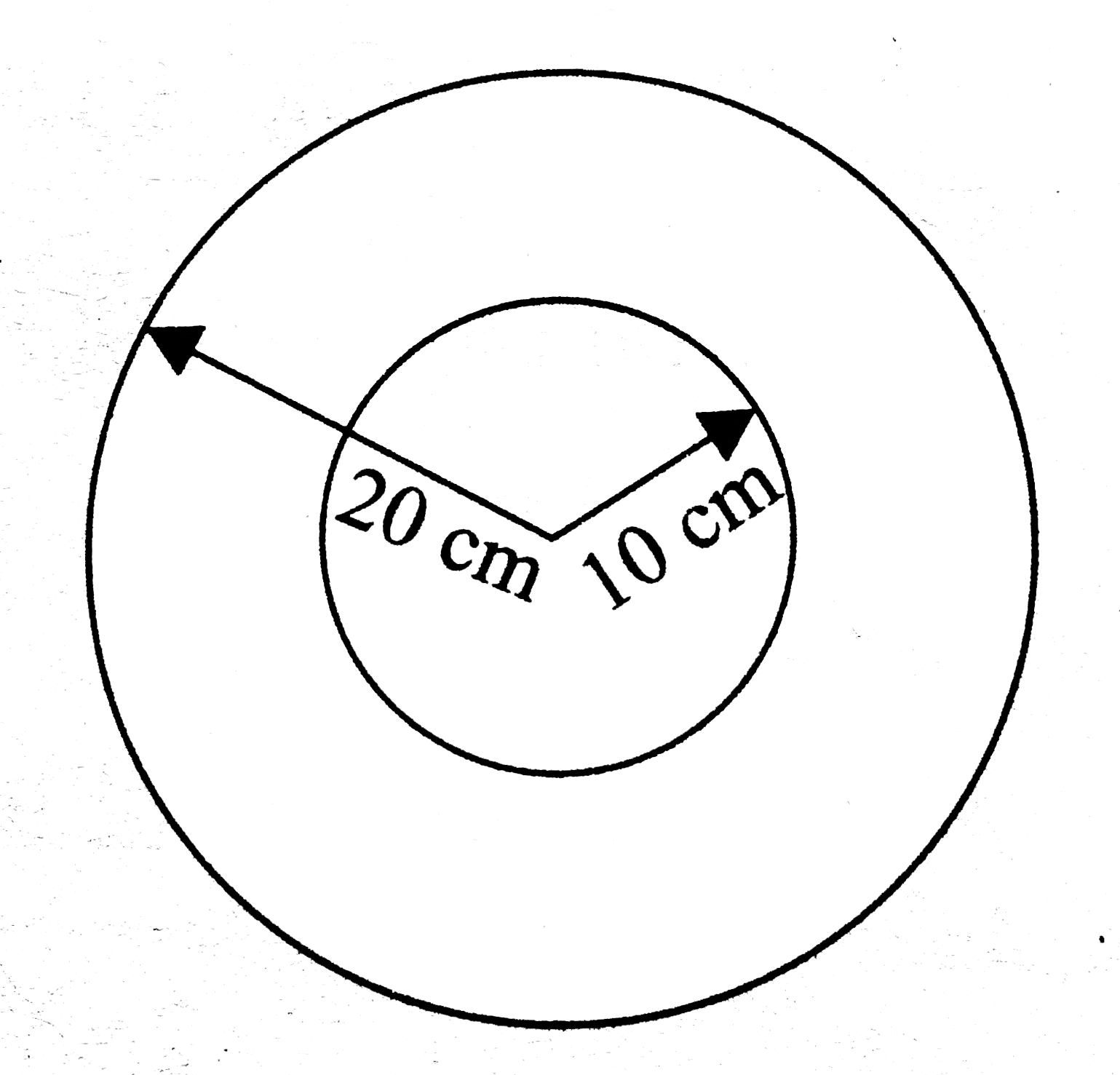 .
.
The electric field intensity just inside the outer sphere.View SolutionQuestion 159
We have an isolated conducting spherical shell of radius 10cm. Some positive charge is given to it so that the resulting electric field has a maximum intensity of 1.8×106NC−1. The same amount of negative charge is given to another isolated conducting spherical shell of radius 20cm. Now, the first shell is placed inside the second so that both are concentric as shown in (Fig. 3.154).
 .
.
The electrostatic energy stored in the system is.View SolutionQuestion 160
We have an isolated conducting spherical shell of radius 10cm. Some positive charge is given to it so that the resulting electric field has a maximum intensity of 1.8×106NC−1. The same amount of negative charge is given to another isolated conducting spherical shell of radius 20cm. Now, the first shell is placed inside the second so that both are concentric as shown in (Fig. 3.154).
 .
.
If both the spheres are connected by a conducting wire, then.View SolutionQuestion 164
An uniform electric field of strength E exists in a region. An electron of mass m enters a point A perpendicular to x - axis with velocity V. It moves through the electric field and exists at point B. The components of velocity at B are shown in (Fig. 3.156). At B the y - component of velocity remain uncharged.
 .
.
Find electric field. View SolutionQuestion 165
An uniform electric field of strength E exists in a region. An electron of mass m enters a point A perpendicular to x - axis with velocity V. It moves through the electric field and exists at point B. The components of velocity at B are shown in (Fig. 3.156). At B the y - component of velocity remain uncharged.
 .
.
Find velocity at B. View SolutionQuestion 166
An uniform electric field of strength E exists in a region. An electron of mass m enters a point A perpendicular to x - axis with velocity V. It moves through the electric field and exists at point B. The components of velocity at B are shown in (Fig. 3.156). At B the y - component of velocity remain uncharged.

Find the rate of work done by the field at B. View SolutionQuestion 167
There are 27 drops of a conducting fluid. Each drop has radius r, and each of them is charged to the same potential V1. They are then combined to from a bigger drop. The potential of the bigger drop is V2. Find the ratio V2/V1. Ignore the change in density of the fluid on combining the drops.View SolutionQuestion 168
Figure shows two conducting thin concentric shells of radii r and 3r. The outer shell carries charge q and the inner shell is neutral . The amount of charge that flows from the inner shell to the earth after the key K is closed is equal to (1/n)th of the charge on the outer shell. What is the value of n ?
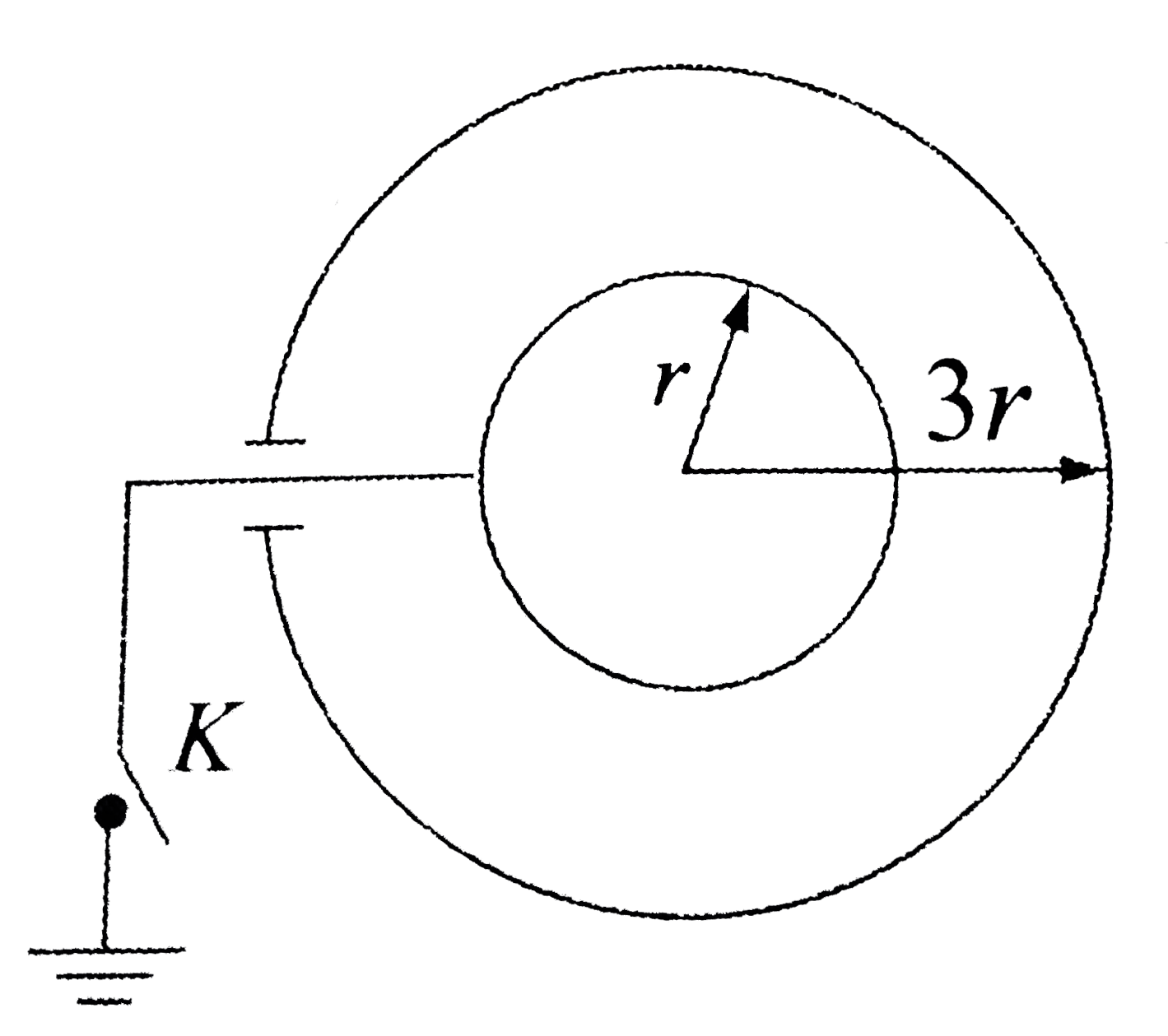 .View Solution
.View Solution
 .
. .
. .
.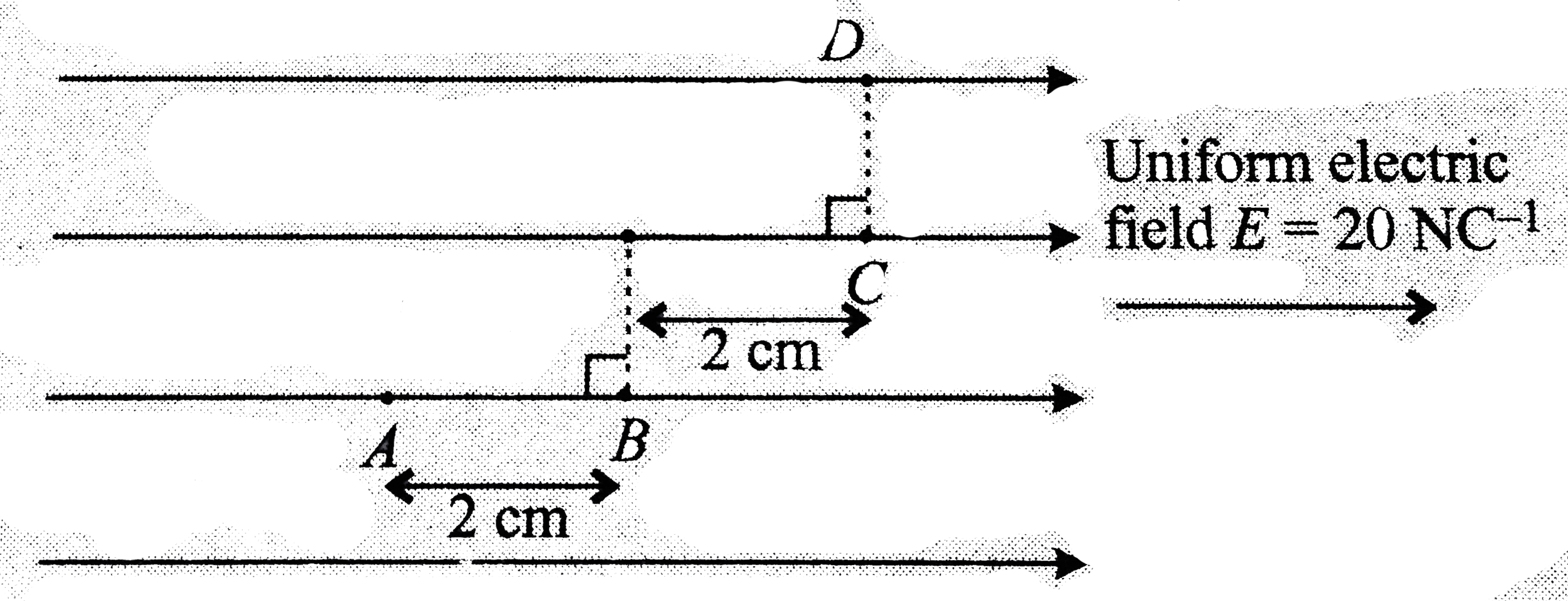 .
. ,
, .
. .
. .
. .
. .
. .
. .
. 
 .
. .
. .
.  .
.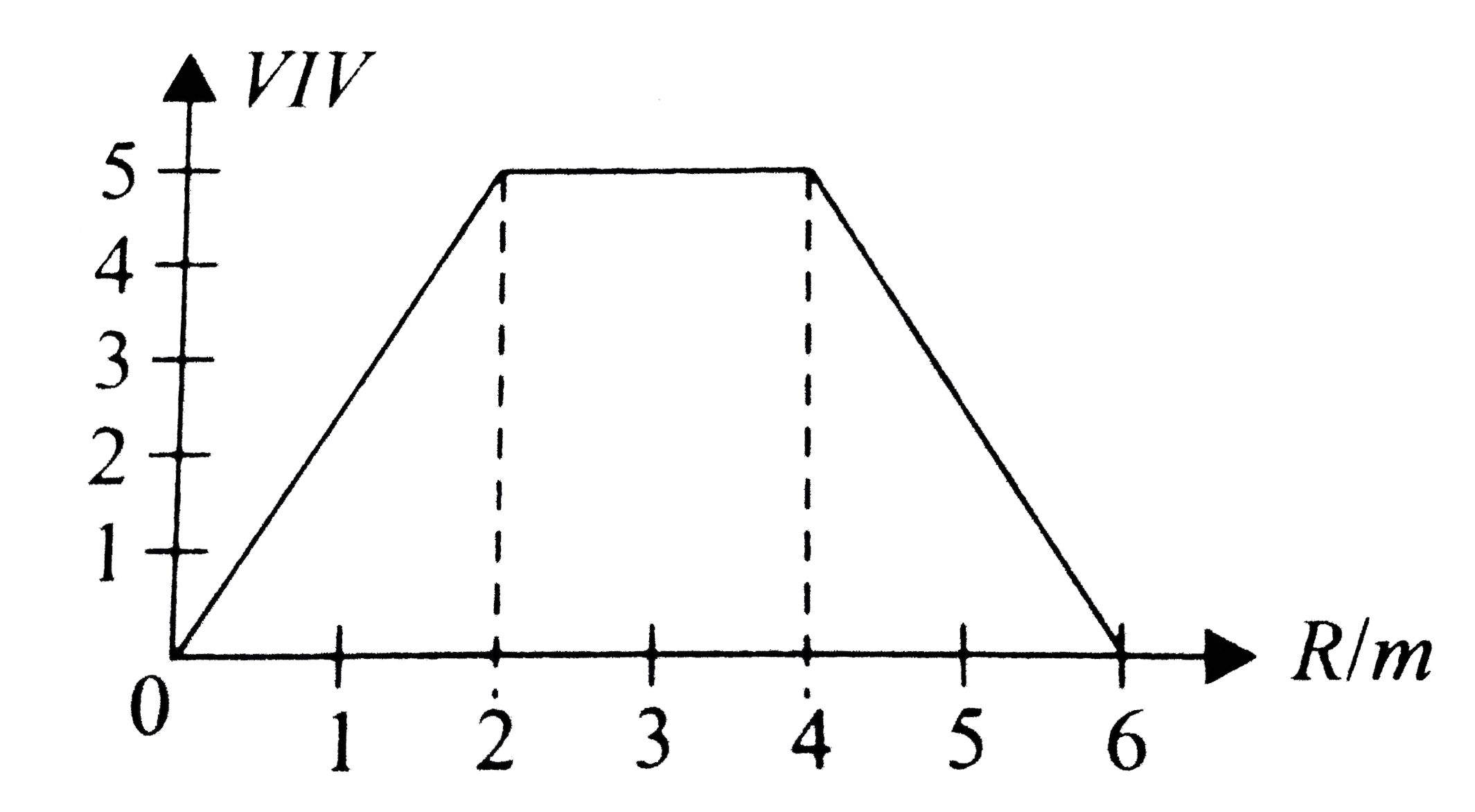 .
.  .
. .
. .
.
 .
. .
. .
. .
. .
. .
.
 .
. .
. .
. .
. .
. .
.
 Draw the graph of electric field strength.
Draw the graph of electric field strength. 
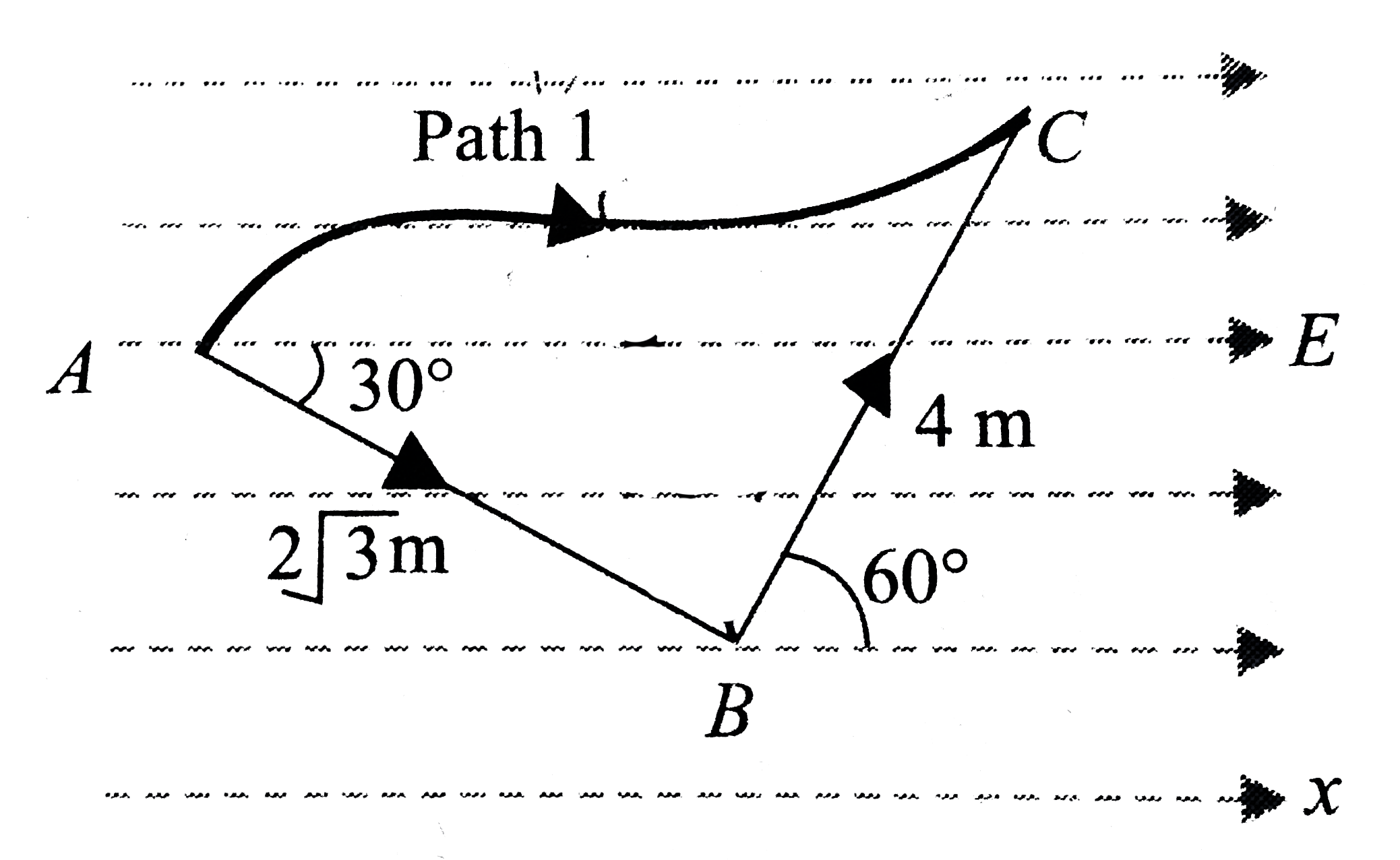 .
.  .
.  .
.